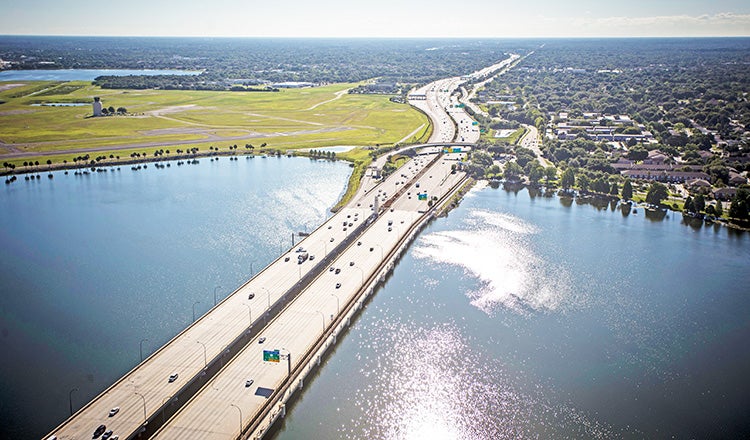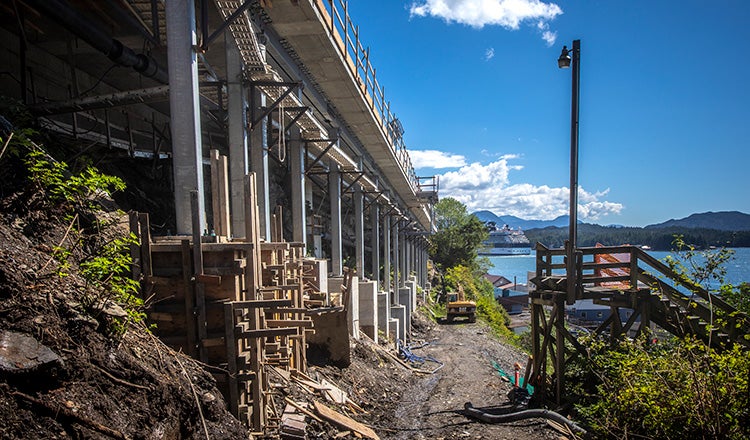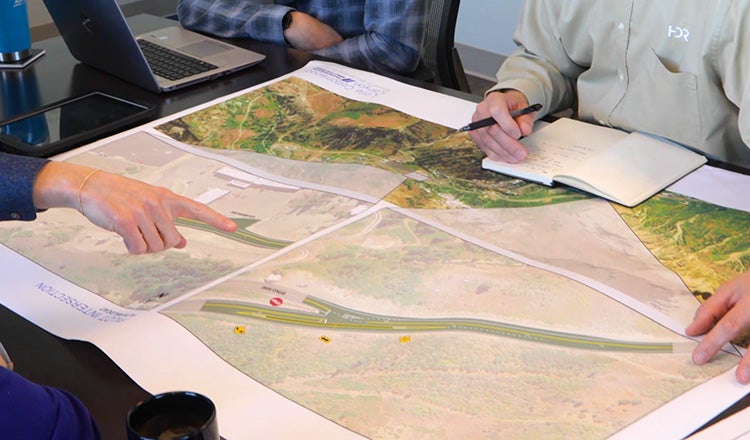
Experts Talk: Expediting the Infrastructure Environmental Review Process with Diane Nulton and Taylor Horne
Experts Talk is an interview series with technical leaders from across our transportation program.
Finding Success in Federal Programs Like NEPA Assignment
The U.S. environmental review process can be one of the most time-consuming parts of planning for a major infrastructure project. While important for safeguarding our communities and their future, the process can also be protracted and duplicative. Streamlining this process has been the focus of numerous efforts, including regulations that allow federal review under the National Environmental Policy Act to be delegated to states via a process called NEPA Assignment. Recently updated regulations also now require completing environmental assessments within one year and environmental impact statements within two years.


Finding efficiencies to expedite the review process can help important infrastructure projects advance quickly and remain viable while maintaining the needed emphasis on environmental protection. Using federal programs such as NEPA Assignment and others allow states to speed up the process by assuming some responsibilities administered by federal agencies. While the application process can be daunting and states should be aware of potential challenges, these programs hold important benefits for states that are looking to expedite their major projects.
Senior Environmental Project Manager Diane Nulton and Senior Transportation Environmental and Planning Lead Taylor Horne have decades of experience navigating the NEPA process. While working for the Alaska Department of Transportation and Public Facilities, Horne was the statewide environmental program manager and led the negotiation that resulted in Alaska’s successful implementation of NEPA Assignment. Nulton has worked with transportation agencies across the U.S., helping guide complex programs through the NEPA process, authoring and teaching courses on FHWA NEPA requirements, updating agency handbooks and explaining the complex environmental review process. In this interview, they describe the federal programs that states can use to streamline reviews, the benefits and drawbacks of these programs and how to best implement them.
Q. Describe the federal programs available to state transportation departments to streamline the environmental review process by delegating authority.
Horne: Until recently, there were two main programs that allow a state transportation agency to assume the federal government's responsibility for completing the environmental process under NEPA.
- NEPA Assignment (23 U.S.C. 327): Formally known as the Surface Transportation Project Delivery Program, this program allows states to take on all classes of actions under NEPA, including EAs and EISs. States are assigned the environmental review responsibilities of federal agencies. The requirements for review are the same, but the state is responsible for completing that review, rather than a federal agency such as the Federal Highway Administration, the Federal Transit Administration or the Federal Railroad Administration.
- CE Assignment (23 U.S.C. 326): This program allows state transportation agencies to take over approving categorical exclusion determinations, finding that specific actions will have no significant effect on the environment, and therefore, neither an EA nor an EIS is required. Most projects — 90-95% — are covered by categorical exclusions. Under the CE Assignment program, federal agencies are still responsible for overseeing EAs and EISs. With fewer requirements and covering most projects, the CE Assignment program has been used in the past as a stepping stone of sorts to taking part in the full NEPA Assignment.
To date, seven states have assumed full NEPA Assignment responsibility — California, Texas, Ohio, Florida, Utah, Alaska and Arizona. An eighth state, Nebraska, has taken on CE Assignment and full NEPA Assignment is well underway. HDR has helped six of the eight states and is the national leader in helping states through the NEPA Assignment process.
Nulton: In December 2020, a third program was added to CE Assignment and NEPA Assignment: The Eliminating Duplication of Environmental Reviews pilot program. This new program builds on the same theme as CE and NEPA Assignment, giving states more responsibility in the review process.
Some states have their own state-level environmental review laws in addition to following the federal NEPA law. In these instances, the state requirements may be more or less stringent than the federal requirements and the same documentation may end up being prepared twice — once for state requirements and once for federal requirements, especially if the class of action (CE, EA or EIS) is different for the state vs the federal laws. In the new pilot program, the federal government will accept up to two states that will be allowed to use their state process to satisfy both state and federal requirements, greatly reducing duplication. To qualify, states choosing to pursue the program would need to show that their state procedures are as stringent, or more stringent, than the federal procedures. Importantly, for any state considering this program, states must already be taking part in the NEPA Assignment program.

Q. What are the benefits of using one of these federal programs?
Nulton: Any state transportation agency, like a state DOT, that receives federal funding for a project must complete the NEPA process. Often, that can be a long and cumbersome process with many approvals along the way. In most cases, the state DOT and federal agency reviews of information and documentation are sequential rather than concurrent. One major advantage of these assignment programs is that they eliminate a step in the review and approval process, which means less paperwork and less review, revision and backchecking time. And any time you're saving time, you're ultimately saving money.
The time savings can be significant. In California, for example, the state’s 2019 report on their NEPA Assignment shows draft EA/EIS approvals are completed 12 to 25 months faster compared with approvals before it started the program.
Horne: Taking advantage of one of these programs puts the states in the driver’s seat. They allow a state DOT to directly consult and negotiate with federal agencies acting as a lead agency themselves rather than using the FHWA or another funding agency as an intermediary. It gives states a seat at the table during discussions with federal agencies and a direct line of communication.
More control can also mean more flexibility. When recently overseeing the NEPA Assignment program in Alaska, one of the biggest benefits I observed was the ability to innovate without having to ask FHWA for permission on every adjustment. The environmental requirements we met did not change, but how we met them — the procedures and forms and processes — could flex and become more efficient.
NEPA Assignment also helped deliver more transportation benefits to the public sooner. If you can complete major projects faster and cheaper, there's more capacity in your pipeline. And that means there should be more federal aid available for other projects.
Q. Why haven’t more states used them? What are the drawbacks or hurdles?
Nulton: The hesitations can vary. In the case of this new pilot program, it requires state environmental requirements that are stricter than federal requirements and a current NEPA Assignment agreement. Only seven states currently have full NEPA Assignment and not all of those have state environmental regulations that are as strict or more so than federal requirements.
When pursuing CE or NEPA Assignment, some states may have a great relationship with their federal agency contacts and may not want to put in the time and effort to change a process that seems to be working well already. Depending on the state, some also deal with the EA/EIS process much less often, with a handful of projects every few years, making the benefits less appealing.
Horne: The whole application process is a large hurdle, as it’s complicated and requires an upfront investment to complete. Relying on the expertise of those who have gone through it before and understand the process will help, but it will still require a concerted effort on the part of state leadership.
A major concern for many states is the required limited waiver of sovereign immunity. This action, which typically requires legislative approval, means states can then be sued in federal court for their NEPA actions and decisions. Because this waiver must be passed by legislators who are likely not familiar with the particulars of infrastructure environmental review, it can require some political savvy, some explaining of exactly what is involved in this program and some patience.

Q. What’s the general process of applying for these programs and how long does it take?
Nulton : The process starts with waiving the sovereign immunity for the narrow purpose of these programs. After that, the state submits a letter of interest to the U.S. Department of Transportation.
A federal team then visits the state to explain the program and requirements in more detail. From there, the state is required to complete a meticulous application that shows it is capable of taking on the federal NEPA duties. The state DOT must demonstrate that it has the right number of staff, an independent decision-making structure, proper training and knowledge of the process, and the right quality assurance/quality control structures in place.
Horne : After the initial letter of interest, a public comment period is held on the draft application before a final application and decision. Following that decision, the final step is negotiating a detailed memorandum of understanding that lays out the specific requirements and responsibilities of each party. These negotiations can take quite a while and are often facilitated with the help of an outside consultant and legal expert.
Altogether the process of applying for and implementing NEPA Assignment can take up to two years or more. The process of applying for CE Assignment is typically shorter and for that reason it is sometimes used as a first step prior to seeking full NEPA Assignment.
Q. Where can states benefit from assistance in the application process?
Nulton : To begin with, in big picture strategy. Organising and planning the complex application process can be a challenge in itself. To help our clients prepare, we recommend a facilitated workshop to help leaders prepare for the NEPA Assignment application process and map out a plan. This approach has been successful for the states we have helped.
To successfully take on the NEPA decision-making role, the federal government needs to be assured that the state DOT has the correct procedures in place and its staff is trained to do the job of environmental reviews meeting federal standards. For states that do not have a lot of environmental staff or that have inexperienced staff, it can be a high bar. State DOTs unsure of how their procedure manuals and staff will stack up can undertake or commission a preliminary gap analysis of existing manuals, training and staff knowledge, to address deficiencies before an official FHWA analysis.

Horne : It’s likely that environmental procedures manuals will need to be updated, as HDR NEPA specialists did for Alaska and Utah during their successful applications. New performance measures, QA/QC plans and handbooks will likely need to be created. Training will need to take place on new requirements. Even websites and public-facing materials on the state’s environmental process will need to be updated. In addition to in-house DOT staff, consultants familiar with the process can also be an added resource.
Looming over all of the updates to existing guidance materials is the application itself, which can be hundreds of pages long. Our teams took on this challenge in multiple states, creating draft and/or final applications for submittal to federal agencies.
Finally, the work doesn’t end when the application is accepted and the MOU is signed. NEPA Assignment requires annual audits in a program’s initial years, which require extra effort. Self-assessments are also required. Expanded and continued training may also be needed for employees to ensure staff are following new guidance.
Inspiration & Advice
Q. How did your career lead to a specialisation in NEPA regulations?
Horne: I studied environmental policy, planning and public affairs in school, and I knew that I wanted a career that involved working with the public on environmental issues. After a few years working in western water rights in Washington, I expanded to doing NEPA work for the Alaska DOT&PF, helping them with their CE assignment program at the time. Successfully growing their program into the full NEPA Assignment program was a rewarding challenge. Now I work with HDR on transportation projects in Alaska and across the country. This work is rewarding because it often deals with big, important infrastructure projects and how they can be accomplished with natural and social impacts in mind.
Nulton: With a degree in biology/ecology my first job was with the New Jersey Department of Environmental Protection conducting bioassays at municipal and industrial facilities. After a year or so I transitioned to consulting where I focused on wetland delineations and natural resource assessments, which expanded into work on EISs, many of which were fast-tracked, controversial projects. My next challenge was serving as an extension of PennDOT Central Office environmental staff reviewing documents and developing procedures manuals and training courses for EISs, EAs, CEs, Section 4(f) and other topics. This led to developing NEPA and Section 4(f) courses for the National Highway Institute and teaching courses across the country. Doing the work, reviewing others’ work, developing guidance, teaching others and seeing how many states expedite the environmental process has provided me with a unique perspective and problem-solving skills. I find teaching others and trouble-shooting the controversial and complicated situations most rewarding.
Q. What advice do you have for those entering the environmental review field?
Horne: Don’t be afraid to try new things, take on tasks that appear daunting at first, and never hesitate to ask for advice. I am repeatedly amazed at the thoughtfulness and generosity of folks who work in this field — they are always willing to help out by offering new perspectives and assistance in tackling big challenges that benefit us all.
Nulton: The best way to figure out what you like best in this industry is to try new things. Learn as many aspects of the process as you can. Volunteer to help with traffic counts or shovel dirt for test pits at an archaeological site. Read the regulations and guidance documents relevant to what you are doing. Don’t just follow the last best example; learn why you are doing what you are doing. Think outside the box. Look for innovative ways to do things more efficiently and effectively. When someone says a task is impossible, look for a way to make it possible. Network with others and share your knowledge.
Each Experts Talk interview illuminates a different aspect of transportation infrastructure planning, design and delivery. Check back regularly to read new insights from the specialised experts and thought leaders behind our award-winning, full service consulting practice.


